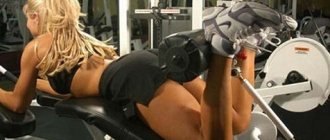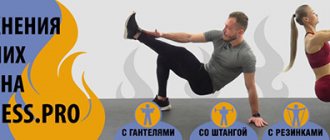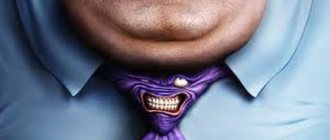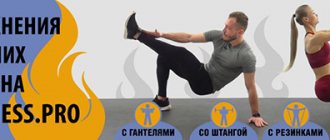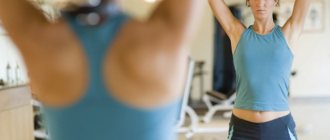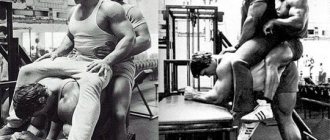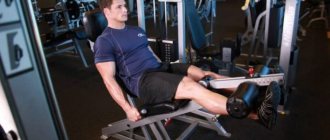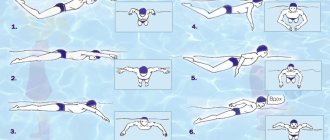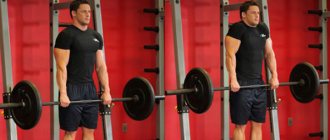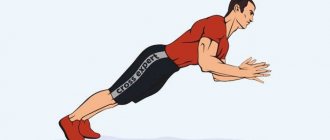Arm curls on a block are an isolating exercise for training the biceps, allowing you to qualitatively stretch the biceps brachii muscle and work each of its bundles in isolation. Cable curls are not recommended for beginner athletes, since this exercise is intended to work the muscles, and not to build muscle mass, since it is difficult to effectively progress the load in this case. It should be noted that block simulators are different, they differ in the places where the hands are fixed, the length of the amplitude, and in general they can differ in any characteristics, but the key points in the technique are the same in all cases. It is also worth noting that in this exercise it is necessary to adhere to Joe Weider’s principle of
It is recommended to perform cable curls in a large number of repetitions to “pump” the biceps and avoid straining the elbow joint. In general, this applies to all exercises with fixation of the elbows, for example, bending the arms on a Larry Scott bench, but in this case it is especially important, because if, when performing bendings on the bench, the athlete can change the position of the body and relieve the load on the ligaments, then in the block of this it won't work. Elbow rotation is also of great importance, which the athlete must choose independently, since the muscle attachment points are different for everyone, which depends on genetics, so the athlete must be experienced enough to have a developed neuromuscular connection.
Correct technique
- To perform this exercise, the lifter will need to attach D-handles to both cables that run through the top pulleys of the machine. The handles should be grasped with an overhand grip, that is, the palms should be facing upward. After this, you need to stand in the middle of the racks of the simulator.
- In the starting position, the arms are fully straightened or remain slightly bent at the elbow joints. However, in any case, the hands go straight to the blocks. They should be in line with the cables that lift the weight from the machine's supports.
- When inhaling, the athlete holds his breath. The biceps tenses as much as possible, the elbows bend and the handles begin to be pulled toward the head.
- When your palms are above the deltoid muscles, you need to stop for a few seconds. After this, the biceps tighten even more.
- Exhaling, the athlete lowers the handles to their original position. This movement is done smoothly.
- The required number of repetitions is performed. On average, it is recommended to do 10 to 15 repetitions in 3 sets. But don't overestimate your strength.
Work of muscles and joints
The goal of the exercise is to isolate the biceps as much as possible, so when performing cable curls, the athlete’s task is to isolate the biceps brachii as much as possible. One way or another, the forearm also receives the load, which can be more or less eliminated with the help of an open grip. An open grip is an arrangement of the fingers of the hand when they are all on the same line, that is, the thumb does not cover the grip from above. The load is distributed approximately evenly between the heads of the biceps, although the internal bundle, of course, is loaded more because it itself is larger and stronger. In addition, the brachialis, whose functions also include bending the arm at the elbow, also receives load.
Arm curls on a block are an isolating exercise, so only one joint works - the elbow. The isolation of the exercise is not due to the fact that it is performed not with a barbell or dumbbells, but in a block, but due to the fact that the athlete fixes the position of his hands, eliminating the possibility of “cheating”, helping himself with his body or shoulders. In general, it is precisely the fact that the athlete fixes his shoulders that forces him to use such a working weight that he can handle when loading the biceps, which is why many people “begin to feel the muscle” and achieve its hypertrophy in block exercise machines. The conclusion follows from this: the progression of loads should be carried out at the expense of the working muscle group, so the athlete must use maximum weight, but the athlete must control this weight.
Safety
Any exercise that is performed in a crossover must have a moderate pace. There is no need to pull the handles too hard or suddenly release them after reaching the top point of the amplitude. This not only tires out the muscles, but also puts enormous strain on the shoulders and elbows.
To protect yourself from unnecessary strain, you need to work with light weight. It is important to keep in mind that this exercise is not recommended for beginners. The biceps should receive a standard load for six months, and then the athlete can begin crossover deadlifts.
In no case should you forget about warming up .
In this exercise it is especially important, since the biceps must be toned. Otherwise they may be injured. You can use dumbbells or barbells as warm-up exercises.
Basic mistakes
Too much weight
This is the scourge of the modern world. Every person wants to express themselves and be noticed. And instead of discovering the dormant talent in themselves, people working out in the gym try to show everyone who they are. And they grab dumbbells that they are not yet able to lift. Because of this, the execution technique suffers and the effectiveness of the exercise will decrease. This increases the risk of injury to your elbows and shoulders. If the longevity of your joints is important to you, then choose the right weight and increase it as your strength increases.
Bending arms by inertia
This is a very dangerous technique that should be avoided by all bodybuilders regardless of skill level. It looks like this. We lift the dumbbells up and then relax our arms. They straighten under the weight of the burden. This creates a see-saw effect. Which greatly affects our elbows. And over time, this will definitely lead to injury.
Flexion due to a large number of assistant muscles
As you understand, we are talking about “Chitting” (Forced repetitions with the help of other muscles). I have already said that if we keep this process under control and understand what we are doing. Then it turns into a tool that will help you get the most out of your muscles. But if we resort to it unconsciously, this especially often happens when athletes take too much weight. Instead of efficiency, we put our joints at risk.
That's basically all I wanted to share with you in this article. You can use these options either separately or combine them into supersets. That is, at the beginning you do an exercise for the length of the head, and then finish off the biceps with curls with an emphasis on the short one. Choose a medium rep range of 12-20 reps for 3-4 sets. And your biceps will gradually take on the shape you wanted.
Good luck to everyone in your training!
Common mistakes
Movement of the body while bending the arms . Indeed, this action helps the athlete bend his arms under the influence of heavy weight, but why do this if part of the load will go to the back muscles? The lat crossover curl is aimed at developing the biceps, so reducing the load may make this exercise less effective.
Making unnecessary shoulder movements . This mistake primarily concerns those athletes who are performing this exercise for the first time. Under the influence of the cables, the body begins to sway and the shoulder joints shift slightly. It is very important to keep them still as they can easily become dislocated under the weight.
Uneven execution . Most people have uneven development of the right and left arms, so you want to pull the weight with your dominant arm, and only help a little with the other. In the future, this leads to the fact that the additional hand begins to lag behind, and the main one, on the contrary, develops too much. To prevent this from happening, it is recommended to slightly weaken your dominant hand.
Alternating arm rows . Some athletes mistakenly believe that alternating arm rows will help build better biceps. This is not entirely true, because the right hand (for right-handed people) will constantly pull harder and will therefore develop better. In addition, performing this exercise is fraught with curvature of the spine.
The rating of fat burners will help you get acquainted with the most effective and popular products.
To learn how to properly perform sumo squats with dumbbells, go here - /silovye/yagoditsy/prisedaniya-sumo-s-gantelyami.html.
What muscles are used by dumbbell curls?
Dumbbell curls target the front of the arm muscles. Namely:
Biceps.
This is the biceps brachii muscle. Consists of two heads.
- Short.
Located closer to the body. More involved when moving the elbows back. In this position, she is in a more extended position. Therefore, it can use its full potential. - Long.
Located more laterally (farther from the body). One of the functions of the biceps is to help the anterior deltoid lift the arm up. Therefore, in order to use it, you should put your elbows forward.
But that's not all. We can also stretch one or another head by simply increasing or decreasing the distance of the arms relative to the body. A narrow setting will shift the emphasis to the long head, and a wide one to the short one. If you stay in a neutral position, your hands are shoulder-width apart. Then the biceps heads will receive the same load.
Interesting fact. The short head is actually larger than the long one. And it is called that because of the size of the tendons.
Brachialis.
This is an internal muscle. Located under the biceps.
These two muscles are very important for the formation of biceps. They are united by a common function. We are talking about bending the arm at the elbow joint. As you can see, the exercise is called exactly the same.
Brachioradialis
muscle.
This is the muscle of the forearm. It is attached to the humerus and helps bend the arm at the elbow joint. It also participates in supination along with the biceps.
Curling arms with dumbbells
And of course, we must not forget about the fact that the tendons of the long head are located under the deltoid muscles. Plus, they work statically, helping us hold the dumbbells in our arms down. Therefore our deltas too
work in this exercise. If the technique is incorrect, they can take the initiative into their own hands. Therefore, our task is to prevent this from happening.
Useful tips
- The key to achieving maximum contraction of all working muscles is complete upper arm stability. When raising and lowering your elbows, the load is removed from the biceps, so the exercise becomes ineffective.
- Bending both arms should occur simultaneously, at a moderate pace.
- There is no need to perform the exercise with only one hand, since in this case it is very difficult to keep the torso in an even position.
- Holding your breath helps keep your body motionless and also makes it possible to concentrate all your attention on muscle contraction.
- If the height of the blocks can be adjusted in the simulator, then they should be installed slightly higher than the shoulders. This will make it possible to perform the exercise at the optimal amplitude. If the blocks are placed too high, it will shorten and the biceps will receive less load.
- No need to relax your hands. They are always under tension to avoid injury.
You can bend your wrists slightly as your arms begin to approach the top point. This will increase the load on the forearms, which will have a beneficial effect on biceps contractions.
Exercise "Hammer"
Curling arms with dumbbells, as mentioned above, can be performed while sitting or standing. The next exercise called “Hammer” is no exception. Its distinctive feature is that it is performed standing and without turning the hand towards you.
Technique:
- While standing or sitting, lower your arms with dumbbells down so that your hands are turned towards your body.
- Inhale and bend one or both arms at the elbows, maintaining the position of the hand. Pull the dumbbells toward your shoulders. Exhale at the highest point.
This exercise is also considered isolated, but is aimed mainly at the brachioradialis muscles, as well as the biceps. The brachialis and extensor carpi radialis muscles are less involved.
The “Hammer” exercise for the biceps is considered the most optimal and safe, as it puts minimal stress on the elbow joint. During the exercise, he is in his natural position.
Features of biceps training
The biceps consists of two bundles
. The long head is located on the outside of the arm and is more visible to the eye. The short head is located on the inside of the arm.
Since the biceps is responsible for flexion and extension of the arm at the elbow
, then all biceps exercises come down to these movements. The exercises presented will differ in the starting position, hand grip and forearm position.
Tips for doing biceps exercises with dumbbells at home or in the gym:
1. When performing biceps exercises with dumbbells, only your forearms should move. The body remains stationary
and does not start working. The tension should only go to the biceps.
2. When performing biceps exercises, control every movement, avoid jerking and swaying. Perform the movements slowly
- only in this case the muscles will receive maximum load.
3. During biceps training, the forearm muscles are also involved in the work.
4. You can practice either alternating curls with dumbbells or simultaneously. But for greater efficiency, it is recommended to perform alternate bending of the arms
. This will take you more time, but it will help you better feel and work the target muscle.
5. If you want to pump up
biceps, perform 3 sets of 10-12 repetitions on each arm with the maximum possible weight.
If you just want to strengthen
the muscle and achieve relief, perform 5 sets of 20-25 repetitions with medium weight. Gradually increase the weight of the dumbbells.
6. If you plan to perform biceps exercises with dumbbells at home, then instead of a bench you can use a fitball
.
7. The size of the biceps is determined, among other things, by genetics.
predisposition, so the rate of its growth is very individual.
8. Use different biceps exercises to avoid muscle addiction and falling
results.

